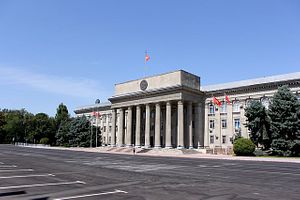Last week, on July 3, Kyrgyz President Sooronbay Jeenbekov signed a decree setting out the official date of the country’s next parliamentary elections. The date has been set for October 4, despite some chatter that it could be delayed; what will happen remains uncertain. The October 2020 parliamentary elections will take place within the context of a tumultuous political moment in Kyrgyzstan and a pandemic.
In order for parties to contest the election, they have to first notify the Central Election Commission (CEC) of their intent to run and send representatives to the CEC by July 13. Before August 24, parties have to hold a party congress at which they compile their list of candidates and pool the financial resources necessary to run. Deputy head of the commission, Abdyzhapar Bekmatov, told 24.kg that parties must form an election fund and pledge 5 million Kyrgyz som (about $64,000).
Registration of parties will end on September 3 and the campaign period will begin the next day. Missed deadlines or lists that don’t adhere to specific quota regulations would result in non-registration of a party. Kyrgyzstan’s parliamentary system does not, at present (though it has in past iterations) allow for independent candidates.
To date, 35 political organizations have notified the CEC. Parties are expected to hold their congresses to hammer out their party lists virtually, given that mass gatherings are still prohibited due to the ongoing pandemic.
As an illustration of the pandemic threat, at least 10 employees of the Central Election Commission have tested positive for COVID-19. According to 24.kg, they’re self-isolating and commission meetings are taking place via Zoom.
Among the parties that have announced their intent to run is the Social Democratic Party of Kyrgyzstan (SDPK), under the leadership of Sagynbek Abdrakhmanov. The party previously provided Kyrgyzstan’s current president, Jeenbekov, and his predecessor Almazbek Atambayev, but the fallout between the two presidents has fractured the SDPK — which holds the most seats in the present parliament. At first, the split was between pro-Atambayev and anti-Atambayev forces, which coalesced under Abdrakhmanov (who was expelled from the SDPK in the 2017 run-up to the presidential election). The split has since widened, with infighting amid the pro-Atambayev wing and a lack of energy beyond distaste for Atambayev on the anti-Atambayev side.
Other SDPK members are jumping ship more decisively in hopes of remaining politically relevant after October. For example, current SDPK MP Ryskeldi Mombekov, who left the pro-Atambayev wing of the party’s political council in late May (though he appears to technically still be a member of the party), has tossed in with the emergent Zhany Dem movement. Zhany Dem, which means “new breath,” includes an array of parties including Omurbek Tekebayev’s Ata-Meken, former Prime Minister Temir Sariyev’s Ak-Shumkar, and Zhanar Akayev’s Kyrgyz Liberal Democratic Party along with additional politicians and activists.
The alliance looks like it will compete under Ata-Meken’s banner in the election; at least that’s what Tekebayev told 24.kg in June.
After the last parliamentary election, in 2015, a total of six parties entered parliament: SDPK (38 seats), Respublika-Ata Jurt (28 seats), Kyrgyzstan (18 seats), Onuguu-Progress (13 seats), Bir Bol (12 seats) and Ata Meken (11 seats). Three of those parties (Kyrgyzstan, Onuguu-Progress, and Bir Bol) were new to the parliament at the time; Respublika-Ata Jurt was an alliance of two existing parties that shortly after the electron fell apart everywhere but in the parliamentary faction. At the time, SDPK was ascendant after more than a decade of work and after harnessing the forces driving Kyrgyzstan into its second revolution in 2010.
October will be a wild ride for Kyrgyz politics. Not only is the field a confusing mess, but the rules have shifted slightly, too. In 2017, the national threshold for parties was raised to 9 percent — recent legislation signed into law has lowered it back to 7 percent. (Colleen Wood reviewed the threshold question earlier this year.) And then there’s the pandemic and the attendant complexities of running an election amid a public health emergency, the future of which is unclear.
Before even decreeing the date of the election Jeenbekov lectured lawmakers in parliament to act responsibly, not overpromise in their platforms, and refrain from deceiving voters. How free and fair Kyrgyzstan’s upcoming election can be — amid the mire of politics and disease — will be a heavily debated question.
(For more about Kyrgyzstan’s parliamentary elections, check out my piece in the July issue of The Diplomat Magazine)

































